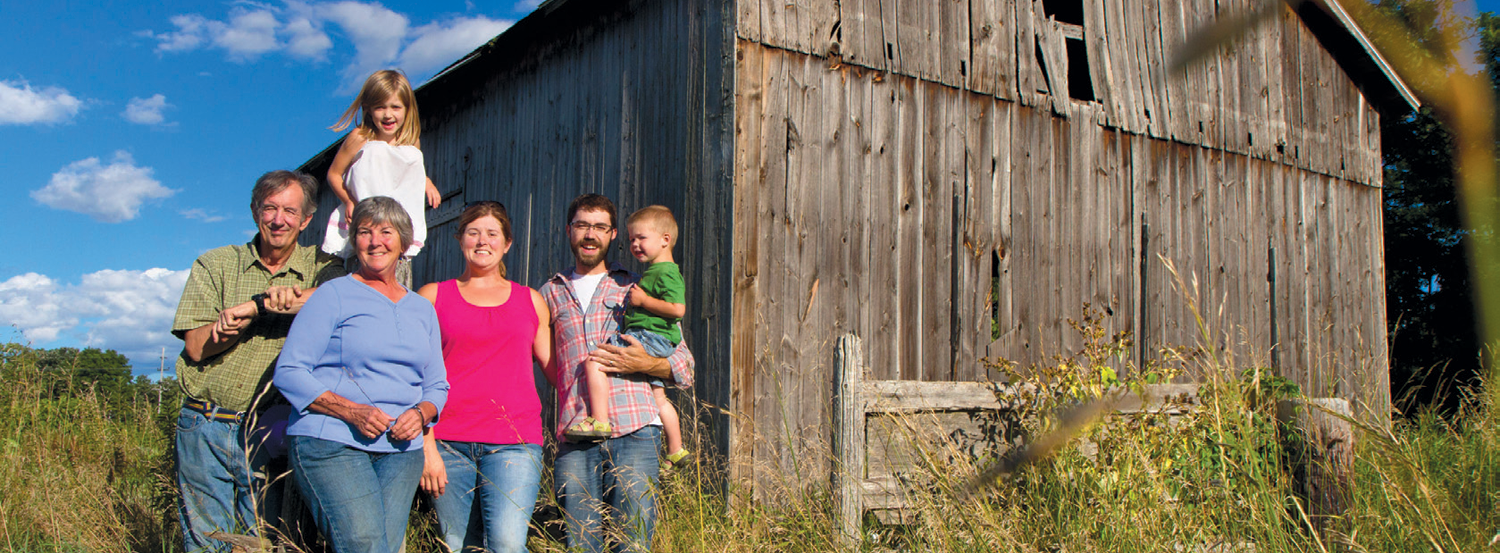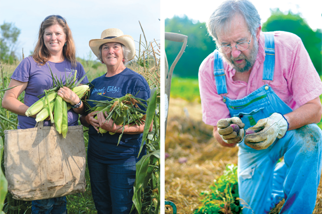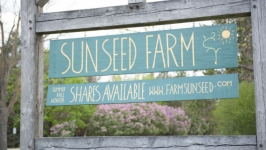Thread Creek Farm
Thread Creek Farm in Grand Blanc could just as easily be named for the familial thread that weaves together generations as for the actual creek that runs through it.
The centennial—and then some—farmstead began when Ginny Knag’s great-great-grandfather, Jonathan Davidson, settled there in 1831 from upstate New York. He built the original portion of the house in 1835 and enlarged it later as part of the post–Civil War boon. Outbuildings quietly call to mind the busy 19th-century carpenter, blacksmith and dairy farmer.
“It’s been in our family, continuously farmed, since then,” says Ginny, who grew up and raised her own children there like her father did before her.
Originally a dairy farm, the 135 acres fed the farm animals and the family. Then suburbanization rapidly overtook the area in the 1950s and ’60s.
“When the grain elevator closed, it changed the dynamic of the county,” Ginny says. Area farmers struggled with where to take their crops and how to make ends meet. “We became too small to be big and too big to be small.”
The farm shifted its focus and became a place for the influx of new young families to start family traditions—a U-Pick pumpkin farm—helping to offset other costs from the changing landscape.
Today pumpkins and related decorative gourds, corn varieties and cornstalks remain the farm’s biggest business, with the farm earning half of its annual income in September and October alone. But don’t expect any agritainment, says Ginny: “It’s low key and more natural. We don’t do hayrides.”
A survey of the beautiful rolling fields, bordered by woods and sugarbush, instantly conveys why the family arranged for North Oakland Headwaters Land Conservancy to hold the development rights to 90 acres of the land. “I was determined to find a way to help ensure it would not be developed,” Ginny explains. “It can be used for agriculture. It can be used for conservation. There are only a couple of areas where you can build a structure.”
And it can be a food source for families. Thread Creek is in its fourth year as a community-supported agriculture (CSA) harvest subscription program, a model researched by Mike and Ginny’s daughter and son-in-law, Emma and Brandon Blinkenberg.
Emma met Brandon at Michigan State University in 1998 and they settled in the Lansing area. Their daughter Sara arrived in 2008 at a time when news of contaminated spinach and peanut butter filled the airwaves, reigniting the young couple’s commitment to know their food sources. They also knew where that lifestyle could flourish.
“We were watching and waiting,” Emma says, referencing her parents. “And they were waiting for someone to say ‘Hey, we want to farm with you.’”
The Knags had wondered if one of their three children would want to continue the farm, which they had inherited when her parents died in 2008. It was the only time in Ginny Knag’s life she lived there without another generation sharing the space.
“This has always been a household that housed an extended family,” Ginny says. “It’s just something that, if you were brought up with it and are accustomed to it, it’s a normal thing to do.”
Before long Brandon found a job at University of Michigan Flint, and after son John was born in 2011 the family went straight from the hospital to the farm for good.
“I’m the seventh generation of my family to have lived here. My kids are the eighth,” says Emma, while Sara climbs the tree outside the porch door and John explores nearby.
Long term, Thread Creek Farm plans to increase its chicken population and egg production, once it grows more of the feed to support it. They also plan to raise more cattle, which rotate fields, grazing naturally.
“There’s a big demand for beef and people want to know how it was raised and that the cows had a good life and one bad day,” Emma says.
Expansion happens carefully and with intent. The family traditionally eschews big bank loans that have threatened or even extinguished other farms. “We’ll get there in time,” Emma says. “The benefit of moving more slowly is you don’t have to sell off parts of your farm.”
Instead they appreciate the property and continue to marvel at the nature around them.
“One of the nicest things for me is all the swallows as you go through and disturb the foliage. They swoop down. It’s so beautiful,” says Mike.
His daughter chimes in: “They need open fields to nest on and insects to eat. We really reap the benefits having the land in conservation and that we don’t spray.”
Similarly, the family plants native flowers amid vegetable crops, with the goal of drawing in pollinators and things that might eat pests gunning for the vegetables.
Thread Creek opted to keep its CSA, but to swap farmers’ markets for selling wholesale to the Local Grocer in Flint, to spend more time farming and not farming, Emma explains, and to spend more time with their family.
Find the farm on Facebook @ThreadCreekFarm










